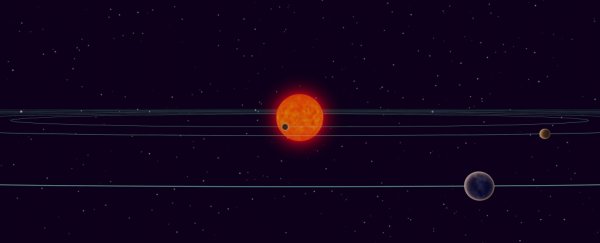The TRAPPIST-1 system is the most tantalising in our local galactic neighbourhood. It's just 40 light-years away, with seven rocky exoplanets, three of which are in their star's habitable zone. But it takes more than that to make a world truly habitable, so astronomers have been seeking characteristics that can tell us more about the system's history.
Now, breathtaking new research has found that, just like the Solar System's planets orbit in a more-or-less flat plane around the Sun's equator - a bit like a vinyl record - so too do TRAPPIST-1's exoplanets orbit in a flat plane around its middle.
This discovery will enable astronomers to probe the system's dynamical history - which can help us to refine models of the system, and rule out habitability on any of its exoplanets. But finding the planets around the star's equator means they're basically orbiting at the same inclination on which they formed, making the system's primordial state easier to study.
To date, astronomers have discovered over 4,000 exoplanets in the Milky Way galaxy, and one of the very important things they can show us is how normal (or not) the Solar System actually is.
Astronomers have taken measurements of the orbital alignment of quite a few exoplanets by now, and many close-orbiting gas giants exhibit what is called stellar obliquity, when a star's exoplanets are orbiting at an oblique angle to the star's spin axis.
Multiple-planet systems tend to be less oblique - but no one had measured it with rocky, Earth-like worlds before. That's because stellar obliquity is measured based on something called the Rossiter-McLaughlin effect, which is hard to observe with small, faint stars like TRAPPIST-1.
Here's how it works. When we're observing an orbiting star, the light from the side rotating towards us will be compressed into higher frequencies towards the blue end of the spectrum. We call that blueshift. The light from the side rotating away from us, on the other hand, is stretched into lower frequencies, or redshifted.
When a planet moves around that star, you can tell which direction it's travelling based on which type of wavelength is blocked out first. And the exoplanet casts a travelling Doppler shadow that creates a distortion that can be used to directly model stellar obliquity.
TRAPPIST-1 is a red dwarf, which means it's very small and faint, so the Rossiter-McLaughlin effect had been impossible to observe before. But the Subaru Telescope located in Hawaii was recently fitted with the InfraRed Doppler (IRD) a new infrared spectrograph with high-enough resolution to make it out.
Next, fortuitously, on the night of 31 August 2018, three of the TRAPPIST-1 exoplanets transited the star in a single night, allowing the team to collect a wealth of data in a single observing run. And it was lucky they did. Only one of the transits produced a reliable Doppler shadow - but it suggested that the stellar obliquity was close to zero.
It's not conclusive yet - there was quite a large margin for error, which means orbital misalignment couldn't be entirely ruled out. But it does suggest some intriguing possibilities for the TRAPPIST-1 system.
During stellar formation, a star is surrounded by a large, flat disc of dust and gas spooling into it. When the star is plumply complete, that remaining dust and gas is what forms everything else. That's why the Solar System's planets are so neatly ordered, rather than fanging about every which way - nothing came along to perturb their alignment, so they just stayed put.
If TRAPPIST-1's exoplanets are in a neat, flat, equatorial plane, then they too probably stayed pretty much where they formed. However, the planets are clustered pretty close to their star; this means that this compact arrangement was probably the result of a gradual inward migration, rather than any other disruptive factor.
It could also mean that the absence of large gravitational perturbations is more likely to result in peaceful, habitable zone planets, although of course reaching that conclusion would require a lot more scrutiny.
But, for now, the team's work is an impressive step forward.
"Despite the limitations of the data, our observation of the Doppler transits in the TRAPPIST-1 system are the first such observations, to our knowledge, for such a low-mass star," they wrote in their paper.
"No other results have been reported for stars cooler than 3500 K. By performing additional observations with the IRD and other new high-resolution infrared spectrographs, a new window will be opened into the orbital architectures of planetary systems around low-mass stars."
The research has been published in The Astrophysical Journal Letters.
